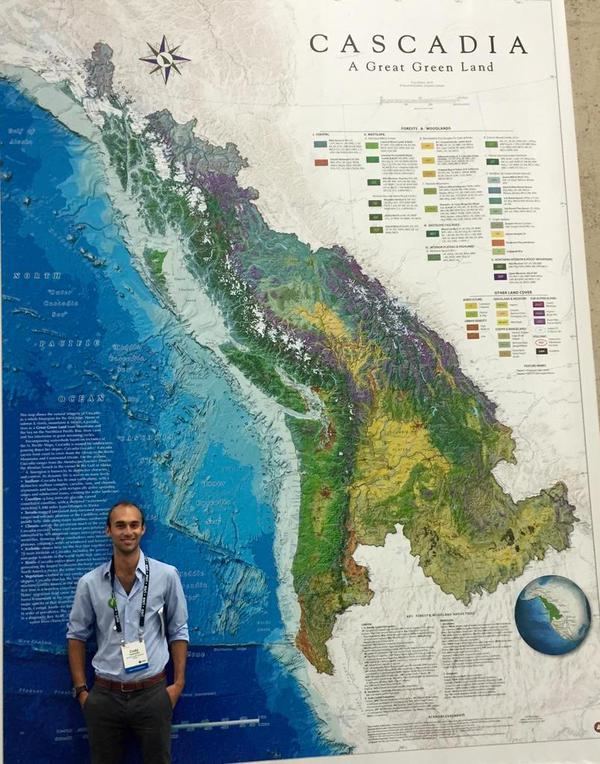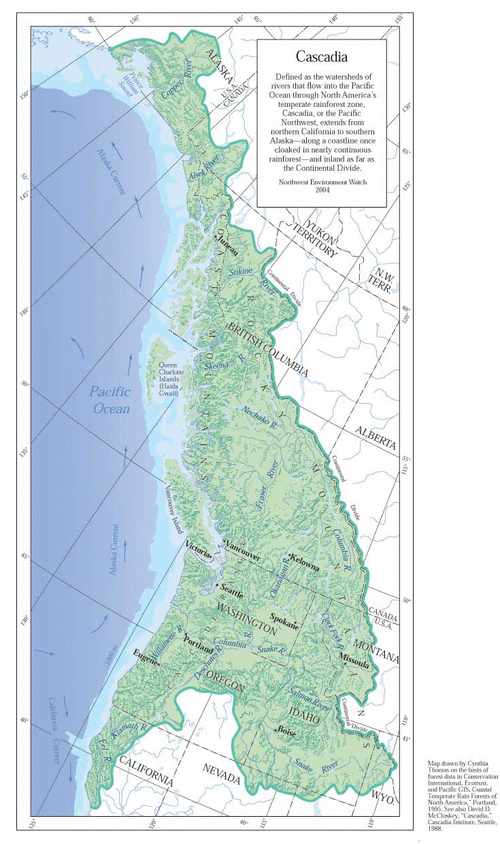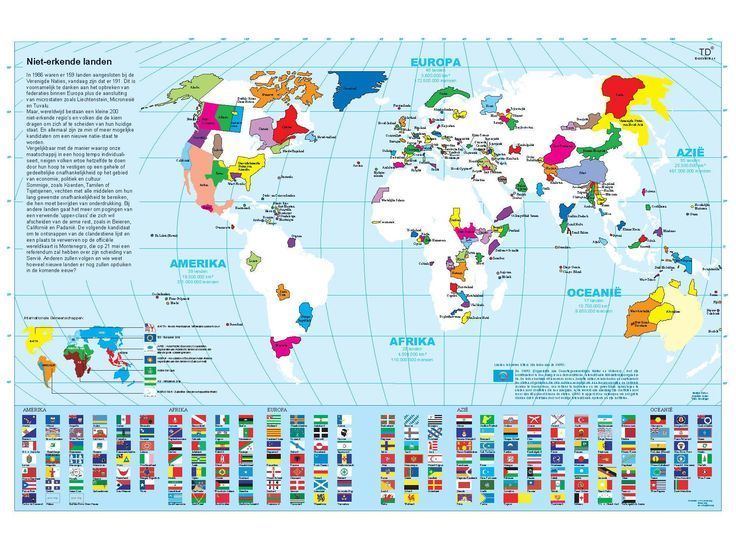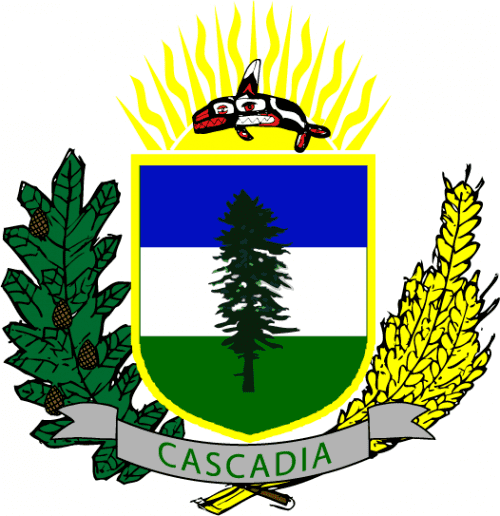Capital undecided GDP (PPP) 2014 estimate HDI 0.914very high Population 15.64 million (2014) | Demonym Cascadian GDP (nominal) 2013 estimate Area 1.385 million km² | |
 | ||
National language Pacific Northwest English, Spanish, Cantonese, Chinook Wawa, multiple First Nations languages | ||
Cascadia is a bioregion and possible proposed country located within the western region of North America. Potential boundaries differ, with some drawn along existing political state and provincial lines, and others drawn along larger ecological, cultural, political, and economic boundaries.
Contents
- Description of the movement
- Oregon Country and Columbia District
- Civil War
- State of Jefferson
- Ecotopia
- Regional identity
- Public support for secession
- Secessionist activism
- Criticism
- In popular culture
- References

The country might consist of Washington, Oregon, portions of other U.S. states and British Columbia, Canada. At its maximum extent, Cascadia would stretch from coastal Southeast Alaska in the north into Northern California in the south, and inland to include parts of Idaho, Western Montana, Wyoming, and Yukon. More conservative proposed borders include the land west of the crest of Cascade Range, and the western side of British Columbia.

As measured only by the combination of present Washington, Oregon, and British Columbia statistics, Cascadia would be home to slightly more than 15 million people (15,105,870), and would have an economy generating more than US$675 billion worth of goods and services annually. This number would increase if portions of Northern California, Idaho, and Southern Alaska were also included. By land area Cascadia would be the 20th largest country in the world, with a land area of 534,572 sq mi (1,384,588 km2), placing it behind Mongolia. Its population would be similar in size to that of Ecuador, Guatemala, or Zambia.

Description of the movement

There are several reasons why the Cascadia movement aims to foster connections and a sense of place within the Pacific Northwest region and strive towards independence. The main reasons stated by the movement include environmentalism, bioregionalism, privacy, civil liberties and freedom, increased regional integration, and local food networks and economies.

The designer of the Doug flag, Alexander Baretich, claims that Cascadia is not necessarily about secession but is rather about survival of peak oil, global warming, and other pending environmental and socioeconomic problems.
Oregon Country and Columbia District
The Oregon Country and the Columbia District are precursors to Cascadia.
An 1813 letter from Thomas Jefferson to John Jacob Astor congratulated Astor on the establishment of Fort Astoria (the coastal fur trade post of Astor's Pacific Fur Company) and described Fort Astoria as "the germ of a great, free, and independent empire on that side of our continent, and that liberty and self-government spreading from that as well as from this side, will insure their complete establishment over the whole." He went on to criticize the British, who were also establishing fur trade networks in the region: "It would be an afflicting thing, indeed, should the English be able to break up the settlement. Their bigotry to the bastard liberty of their own country, and habitual hostility to every degree of freedom in any other, will induce the attempt." The same year of Jefferson's letter, Fort Astoria was sold to the British North West Company, based in Montreal.
John Quincy Adams agreed with Jefferson's views about Fort Astoria, and labeled the entire Northwest as "the empire of Astoria", although he also saw the whole continent as "destined by Divine Providence to be peopled by one nation." As late as the 1820s James Monroe and Thomas Hart Benton thought the region west of the Rockies would be an independent nation.
Elements among the region's colonist population starting in the 1840s sought to form their own country, despite their small number. Oregon pioneer John McLoughlin was employed as the "Chief Factor" (regional administrator) by the Hudson's Bay Company for the Columbia District, administered from Fort Vancouver. McLoughlin was a significant force in the early history of the Oregon Country, and argued for its independence. In 1842 McLoughlin (through his lawyer) advocated an independent nation that would be free of the United States during debates at the Oregon Lyceum. This view won support at first and a resolution was adopted. When the first settlers of the Willamette Valley held a series of politically foundational meetings in 1843, called the "Wolf Meetings," a majority voted to establish an independent republic. Action was postponed by George Abernethy of the Methodist Mission to wait on forming an independent country.
In May 1843, the settlers in the Oregon Country created their first "western style" government as a Provisional Government. Several months later the Organic Laws of Oregon were drawn up to create a legislature, an executive committee, a judicial system, and a system of subscriptions to defray expenses. Members of the ultra-American party insisted that the final lines of the Organic Act would be "until such time as the USA extend their jurisdiction over us" to try to end the Oregon Territorial independence movement. George Abernethy was elected its first and only Provisional Governor, with an opposing faction led by Osborne Russell favoring independence. Russell proposed that the Oregon Territory not join the United States, but instead become a Pacific Republic that stretched from the Pacific Ocean to the Continental Divide.
British claims north of the Columbia River were ceded to the United States by the contentious Oregon Treaty of 1846. In 1860, there were three different statements from separate influential individuals on the creation of a "Pacific Republic".
Civil War
When the Southern states of the U.S. seceded to form the Confederate States of America, some Oregon Territory settlers reacted to the instability of the union as another opportunity to seek independence.
Californians unsympathetic to the Union also pushed for the reestablishment of the Republic of California as an independent entity. The leader of California's federal forces at the outset of the Civil War was himself a supporter of the Confederate cause, but that movement proved weaker than its opposition. For his role in convincing Californians to remain in the Union, Thomas Starr King was honored as one of the two "heroes of California" in the U.S. Capitol's National Statuary Hall Collection until 2009, when his statue was replaced by one of Ronald Reagan.
While independence movements during this time failed to take root, the Pacific Northwest continued to foment a radical and aggressive form of regionalism. This is exemplified by Adell M. Parker, president of the University of Washington Alumni Association, in his speech at the groundbreaking of the Seattle campus:
"That the West should un-falteringly follow the East in fashions and ideals would be as false and fatal as that America should obey the standards of Europe. Let the West, daring and unprejudiced, discover its own ideals and follow them. The American standard in literature and philosophy has long been fixed by the remote East. Something wild and free, something robust and full will come out of the West and be recognized in the final American type. Under the shadow of those great mountains a distinct personality shall arise, it shall adopt other fashions, create new ideals, and generations shall justify them" ("With Due Formality," 1894).
State of Jefferson
After attempts in the mid 19th century at forming a State of Jefferson prior to becoming Oregon and then again in the 1930s, citizens attempted the best known of such movements in the region. During 1940 and 1941, organizers attracted media attention by arming themselves and blockading Highway 99 to the south of Yreka, California, where they collected tolls from motorists and passed out proclamations of independence. When a California Highway Patrolman turned up on the scene, he was told to "get down the road back to California." The movement was created to draw attention to the area by proposing that Southern Oregon and Northern California secede from their respective state governments to form a separate state within the United States. A perceived lack of attention and resources from their state governments led to the adoption of a flag design bearing a gold pan and two X's, a "double cross." The movement quickly ended, however, after the Japanese attack on Pearl Harbor on 7 December 1941.
Stanton Delaplane's coverage of the State of Jefferson won the 1942 Pulitzer Prize for Reporting.
In 1956, groups from Cave Junction, Oregon and Dunsmuir, California threatened to tear Southern Oregon and Northern California from their respective state rulers to form the State of Jefferson.
Ecotopia
Ernest Callenbach's environmental Utopian novel Ecotopia (1975) follows an American reporter, William Weston, on his tour through a secretive republic (the former Washington, Oregon, and northern California) 20 years after their secession from the U.S. At first wary and uncomfortable, Weston is shown a society that has been centrally planned, scaled down, and readapted to fit within the constraints of environmental sustainability.
Regional identity
The idea of Cascadia as an economic cross-border region has been embraced by a wide diversity of civic leaders and organizations. The "Main Street Cascadia" transportation corridor concept was formed by former mayor of Seattle Paul Schell during 1991 and 1992. Schell later defended his cross-border efforts during the 1999 American Planning Association convention, saying "that Cascadia represents better than states, countries and cities the cultural and geographical realities of the corridor from Eugene to Vancouver, B.C." Schell also formed the Cascadia Mayors Council, bringing together mayors from cities along the corridor from Whistler, British Columbia, to Medford, Oregon. The council last met in May 2004. Other cross-border groups were set up in the 1990s, such as the Cascadia Economic Council and the Cascadia Corridor Commission. These groups were established to focus on transportation issues, and have not advocated secession or independence.
The region is served by several cooperative organizations and interstate or international agencies, especially since 2008 with the signing of the Pacific Coast Collaborative which places new emphasis on bio-regionally coordinated policies on the environmental, forestry and fishery management, emergency preparedness and critical infrastructure, regional high-speed rail and road transportation as well as tourism
Under some definitions, Cascadia is energy sufficient, due to the high propensity for renewable energy resources (mostly hydroelectric and geothermal) and supplies many other western states such as California and Idaho with some electricity.
The area from Vancouver B.C. down to Portland has been termed an emerging megaregion by the National Committee for America 2050, a coalition of regional planners, scholars, and policy-makers. This group defines a megaregion as an area where "boundaries [between metropolitan regions] begin to blur, creating a new scale of geography". These areas have interlocking economic systems, shared natural resources and ecosystems, and common transportation systems link these population centers together. This area contains 17% of Cascadian land mass, but more than 80% of the Cascadian population. Programs such as the enhanced drivers license program can be used to more easily cross the border between Washington and British Columbia.
Public support for secession
A research study by the Western Standard in 2005 found that support for exploring secession from Canada was at 35.7% in British Columbia, and 42% in Alberta. While difficult to gauge support specifically in Washington and Oregon, because no research has been done for those states, a nationwide poll by Zogby International in 2008 found that 22% of Americans now support a state's or region's right to peacefully secede from the United States, the highest rate since the American Civil War. However, none of these studies are specifically about forming an independent Cascadia. The movement saw much discussion in the 1990s, and while the increase in security and American nationalism after 9/11 set back the movement's momentum for some time, the concept has continued to become more ingrained into society and the public consciousness. In January 2011, Time magazine included Cascadia number eight on a list of "Top 10 Aspiring Nations", noting it "has little chance of ever becoming a reality".
Secessionist activism
Cascadian secessionist movements generally state that their political motivations deal mostly with political, economic, cultural and ecological ties, as well as the beliefs that the eastern federal governments are out of touch, slow to respond, and hinder state and provincial attempts at further bioregional integration. These connections go back to the Oregon Territory, and further back to the Oregon Country, the land most commonly associated with Cascadia, and the last time the region was treated as a single political unit, though administered by two countries. Some have asserted that political protest in the wake of the 2004 presidential election appears to be the primary reason for renewed separatist movements throughout states with substantial Democratic majorities, such as Washington and Oregon.
On 9 September 2001, the Cascadian National Party website was launched on Angelfire, with the goal of launching a political party dedicated to the independence of Oregon, Washington and British Columbia, but faltered quickly.
Active since 2006, the largest group promoting the idea of Cascadia is CascadiaNow! with more than 9,000 readers on the Cascadia Subreddit 17,976 on Facebook, 3,853 on Twitter, and dozens of members actively working within chapters throughout the Northwest. As a non-profit social movement organization, CascadiaNow! does not actively support secession or any form of political organizing, but instead focuses on Cascadia as a positive, inclusive social and cultural movement. Its goal is to raise awareness about Cascadia, help make a positive impact in the Pacific Northwest, and to build a vibrant and inclusive bioregional community. The organization has been featured in The New York Times, Seattle Times, Crosscut Magazine, The Oregonian, The Portland Monthly and Time Magazine.
One of the few active groups calling for independence is the Cascadian Independence Party. Active since 2013, the majority of organizing is done through online platforms such as Facebook, Reddit, and Twitter, embracing a non-traditional horizontal organizing model.
Other groups discussing the Cascadia concept, such as the Sightline Institute, Crosscut.com, and Cascadia Prospectus, see the concept as one of a transnational cooperative identity, not secession. Still others, such as the Republic of Cascadia, are whimsical expressions of political protest.
Cascadian independence has seen a resurgence in popularity following the election of Donald Trump as president of the United States on 8 November 2016, with a secession referendum proposed in Oregon. The individuals who put forward the proposal have since withdrawn their petition.
Criticism
Critics argue that Cascadian independence is unlikely because of American nationalism, Canadian nationalism, and the stability of the United States and Canada.
Critics note that the American Civil War showed that states had no right and/or power to leave the United States and thus all present states will always be part of the US. Because of this, proponents of Cascadian independence focus on building regional identity and awareness, highlighting distinct social, economic, environmental and cultural features that make Cascadia unique. Because of the historical context of secession within the United States, and a general anti-militaristic sentiment embodied within the movement, organizers envision a peaceful democratic process towards independence through the use of popular vote or a referendum by the people. In contrast, the Clarity Act clarifies that Canadian provinces can leave the Canadian confederation if certain conditions are met. However, no significant movement exists promoting secession.
Another point of contention within the Cascadia movement is the ideological difference between the western portion, often viewed as progressive liberal, and east of the Cascades and Coast Mountains, which tends to hold viewpoints more in line with libertarian conservatism. As Cascadia incorporates many green principles, it could be difficult to obtain local consent for inclusion of eastern Oregon, eastern Washington, and the BC Interior. Inclusion against the popular will would compromise social values emphasized by supporters of the movement, unless the politics in those regions shifted. Other Cascadian ideas such as a decentralized government, increased transparency, and local representation may find more support, and polling data suggests there are distinct cultural values within the Pacific Northwest commonly found on both sides of the Cascade mountains.
